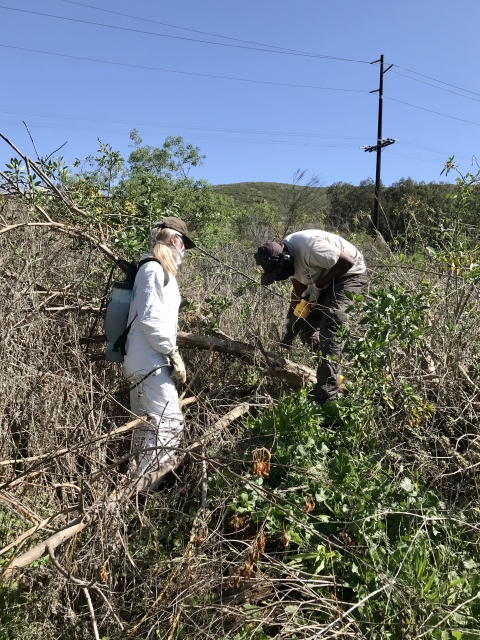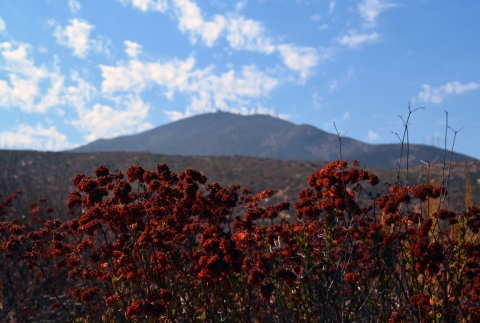What We Do
Since its establishment in 1996, San Diego National Wildlife Refuge has implemented numerous projects to restore and enhance habitat, with a primary focus on supporting listed species and those covered under the Multiple Species Conservation Program (MSCP).
Examples of these efforts include:
- Controlling invasive plant species in burn areas and restored habitats, such as cactus wren restoration sites, vernal pool restoration at the Shinohara site, and Otay tarplant habitat enhancement on the Jamacha parcel.
- Installing fencing and signage to reduce disturbance and minimize impacts from unauthorized off-trail activities.
- Supporting research by the Center for Natural Lands Management on the effects of physical and chemical weed control techniques on San Diego ambrosia, which informs future management practices.
- Coordinating with agencies and organizations to study the effects of herbicides on native species, particularly listed plants, while managing invasive grasses and other non-native plants.
- Inspecting, repairing, or replacing structures such as burrowing owl boxes and bluebird nesting boxes on the Otay-Sweetwater Unit.
Management and Conservation
Additional Habitat Restoration Efforts
Beyond projects focused on listed species, the refuge has implemented several restoration and enhancement activities to improve habitat quality for a wide range of plants and wildlife. These efforts include:
- Controlling invasive non-native plants in recent burn areas.
- Managing invasive grasses and forbs in disturbed areas.
- Removing non-native shrubs and trees from riparian riparian
Definition of riparian habitat or riparian areas.
Learn more about riparian habitats. - Planting and maintaining oak seedlings in suitable areas throughout the refuge.
- Maintaining and monitoring restored cactus patches in areas affected by wildfire.
Refuge Planning
Planning provides the foundation for managing national wildlife refuges. It establishes a broad vision, goals, objectives, and strategies to ensure each refuge fulfills its purpose, aligns with the Refuge System mission, complies with laws and policies, and enhances conservation benefits beyond its boundaries.
Comprehensive Conservation Plans
CCPs are the primary planning documents for national wildlife refuges. As required by the National Wildlife Refuge System Administration Act, the U.S. Fish and Wildlife Service develops CCPs to guide refuge management for the next 15 years. These plans outline how the refuge will meet its purposes and contribute to the Refuge System mission. CCPs also serve as a bridge between broad, landscape-level plans and more detailed step-down plans.
View the 2017 Final Comprehensive Conservation Plan for San Diego National Wildlife Refuge.
Step-down Plans
Step-down plans provide detailed guidance for refuge programs, including:
- Conserving natural resources such as fish, wildlife, plants, and their habitats.
- Protecting other special values, including cultural and archaeological resources, wilderness areas, and wild and scenic rivers.
- Engaging visitors and communities in conservation through wildlife-dependent recreation.
These plans include SMART objectives (Specific, Measurable, Achievable, Relevant, and Time-bound), strategies, and implementation schedules to ensure effective management and conservation benefits that extend beyond refuge boundaries.
Our Projects and Research
Listed and Sensitive Species
To better understand the refuge’s biological resources, staff conduct periodic surveys to assess the distribution and status of plants and animals, with a focus on species that are endangered, threatened, or otherwise considered sensitive or rare. The refuge provides habitat for nearly 50 such species.
Surveys may include mapping the breeding territories of the endangered least Bell’s vireos (Vireo bellii pusillus), a migratory songbird found along the Sweetwater River and its tributaries, or assessing the condition of dot-seed plantain (Plantago erecta), a low-growing plant in coastal sage scrub openings that serves as a host for larvae of the endangered Quino checkerspot butterfly (Euphydryas editha quino).
Information gathered from these surveys helps determine whether populations are increasing, decreasing, or stable. This data may trigger management actions such as controlling invasive weeds that reduce habitat quality or limiting public access to nesting areas during breeding season. Sharing survey results with other agencies and researchers supports recovery efforts across species’ ranges, with the ultimate goal of achieving healthy populations that are no longer at risk of extinction.
Habitat Restoration and Enhancement
Habitat restoration projects improve conditions for listed and sensitive species across the refuge’s diverse habitats. These efforts include:
- Controlling invasive plants in burn areas or sites disturbed by past development or agriculture.
- Removing non-native shrubs and trees from riparian riparian
Definition of riparian habitat or riparian areas.
Learn more about riparian areas to allow native vegetation to thrive. - Planting cactus in burned areas to restore habitat for cactus wrens.
- Planting and maintaining oak seedlings to replace those lost to disease, pests, or past land use.
- Installing nest boxes for burrowing owls and western bluebirds.
- Restoring vernal pools to support species associated with this rare clay soil habitat.
Habitat and Wildlife Protection
The refuge uses a variety of management strategies to minimize disturbance to wildlife and protect water quality from erosion, illegal encampments, and dumping. Staff install and maintain fencing, gates, and signs, and monitor for unauthorized activities such as off-trail use, unleashed dogs, vehicle trespass, and illegal dumping. When necessary, refuge law enforcement officers issue citations for violations.
Abandoned mine shafts are secured with wildlife-friendly gates that allow bats and other small animals to continue using them as habitat. Trails may be rerouted to reduce erosion and protect sensitive habitats and species.
Research and Surveys
The refuge supports a variety of research and resource surveys conducted by graduate students, universities, public agencies such as the United States Geological Survey (USGS) and the California Department of Fish and Wildlife (CDFW), as well as private and nonprofit organizations including the California Native Plant Society, Center for Natural Lands Management, and San Diego Natural History Museum.
All research conducted on the refuge is evaluated to ensure it aligns with refuge purposes and provides benefits to refuge management or resources. Projects by outside parties that are not directly related to refuge management may only be conducted after obtaining a Special Use Permit (SUP) issued by the Refuge Manager.
Southern Border Fuels Project
Learn more about the Southern Border Fuels Project, which focuses on removing non-native invasive plants along the Sweetwater River to improve habitat quality and reduce wildfire risk.
Law Enforcement
U.S. Fish and Wildlife Service law enforcement officers have a wide variety of duties and responsibilities. Officers help visitors understand and obey wildlife protection laws. They work closely with state and local government offices to enforce federal, state and refuge hunting regulations that protect migratory birds and other game species from illegal take and preserve legitimate hunting opportunities.
Laws and Regulations
Any activity conducted off-trails, or any organized group activity on the San Diego NWR must be approved by the Refuge Manager. In order to conduct research, observation, or any other activity, please contact the Refuge Manager Dwane Binns at Dwane_Binns@fws.gov or (619) 385-1190.





